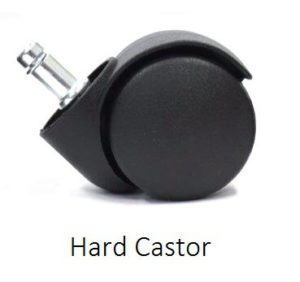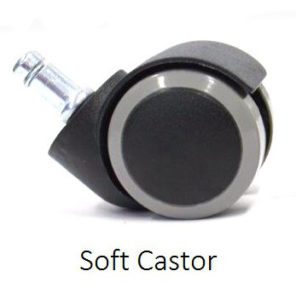What Castors are Best for Carpet?

Hard castors – normal rolling castors – are the most suitable for carpet and are the most common type of castor.
What Castors are Best for A Hard Floor?

Soft castors have more friction and slow down the movement of a chair. They are identifiable by a more lightly coloured castor wheel. These are suitable for hard wooden floors, vinyl tiles, slate or concrete floors.

Glides (fixed feet) are recommended where no movement is desired. Glides are normally utilised with drafting chairs or stools featuring higher gas lifts and foot rings, in environments where stability is important.
Brake unloaded castors limit movement when no one is sitting on the chair, that is, when the chair is unloaded or has no weight on it. Typically used in student labs for safety purposes.
Brake loaded castors do the opposite – they limit movement when the chair has weight on it, but allow the chair to be moved around when no-one is sitting on it.
ESD (electro static discharge) or anti-static castors prevent the accumulation of static electricity from rolling across a floor. This prevents interference with and/or damage to electrically sensitive or volatile materials.
What Is the Best Chair For a Larger Person?
A larger person often requires a deeper seat, a taller back-rest, and sometimes a higher gas strut.
What’s the Best seating for working at a high bench?
Sitting to work at height usually requires a height adjustable chair with a tall gas strut. For safety, the seat pan should not be able to be tilted, and the chair should be stable on the floor surface when getting up or down, with either glides or soft castors. A spider base provides a step-ladder and foot support, while a foot-ring can be adjusted to the right height for users.
What sort of seating should be used in a laboratory?
Laboratories have different seating requirements to the office: moisture, chemicals, static, different table heights, different shifts, multiple users.
Sit-stand and drafting chairs also help people work comfortably. They are particularly useful where people are using microscopes or other specialised equipment.
Chairs for wet or dusty environments need to have suitable seating surfaces, as well as glides or nonslip castors to prevent unintended rolling. Glides or castors for electrostatic discharge can be essential for workplaces handling flammable materials, or delicate electronics. Uplifting Solutions has a wide range of chair bases, including spider bases incorporating a step-ladder, and trumpet bases to eliminate trip hazards.
What seating is PC2 compliant?
Several of our stools and chairs comply with The Australian Government Guidelines for Certification of a Physical Containment Level 2 Laboratory (Version 3.1– Effective 1 July 2007 PC2 Lab), providing cleaning agents comprise mild detergent and water only. Popular choices include the Padded Sit Stand Stool, the AMB Lab Stool, and the Gala Lab Drafting and Desk Chair.
What sort of seating is best for a factory or production environment?
Industrial and production workplaces have different seating requirements to the office: moisture, chemicals, static, different table heights, different shifts, multiple users.
Industrial and lab seating typically needs to be adjustable for a wide range of body types, to take into account workers over multiple shifts who might share the same chair: a contrast to the office environment, where workers usually don’t need to share task seating.
Industrial chairs often need a wider range of movement than office chairs to cope with different shifts, tougher conditions and a wider range of physical movement than in the office.
Sit-stand and drafting chairs also help people work comfortably.
Chairs for wet or dusty environments need to have suitable seating surfaces, and glides or nonslip castors to prevent unintended rolling. Glides or castors for electrostatic discharge can be essential for workplaces handling flammable materials. Uplifting Solutions has a wide range of chair bases, including spider bases incorporating a step-ladder, and “trumpet” or solid bases to eliminate trip hazards.
What’s the best seating for a control room?
A multi-adjustable operator chair is essential for control rooms. For 24-hour operations each person on shift needs to be able to adjust the chair to suit their preferred working position. The chair also needs to be sufficiently robust to withstand 24/7 use.
What if I want a shorter or taller chair?
Uplifting Solutions can tailor chair heights to specific applications, by varying the gas struts supplied with the chairs or stools.
For applications where seat height from floor needs to be from 380mm to 480mm, we can provide a low 80mm stroke gas strut.
For applications where seat height from floor needs to be from 420mm to 550mm, we can supply a medium 140mm stroke gas strut.
For applications where seat height from floor needs to be from 460mm to 660mm, we can supply a high 200mm stroke gas strut.
For applications where seat height from floor needs to be from 590mm to 850mm, we can supply a Sit-stand/drafting 270mm stroke gas strut.
These are indicative ranges; there will be some variations depending on chair, base and castor type. Please note that high back chairs are not available with 270mm stroke gas struts for safety reasons. Call us to discuss your requirement.
I need to lean forward to work. Is there a good chair for that ?
Several of our chairs and stools feature tilt adjustment of the seat pan, especially for forward leaning sit-stand applications, such as for cashier seating or bench tasks. See our sit-stand stool, or the variety of saddle stools for forward leaning applications.
What is the upper weight limit for chairs and stools?
Our chairs and stools range in weight carrying capability from 120 kg to 220kg. Most chairs are weight rated to 120 kg.
Can I add a foot-ring to any chair?
Foot-rings may be added to many of our chairs. Call us to check suitability and pricing.
Can I try one out before I buy?
Samples for contract orders only may be offered on a trial basis.
For small orders for individuals, trials are generally unavailable. The best option is to purchase the item, and try it for a couple of weeks. If it is still in “as new” saleable condition, with the original packaging, please contact us to discuss your return of the item. We will refund the cost of the product itself, but not the freight charges in either direction. You will need to arrange the return freight from your premises to our warehouse. Only stock items are able to be returned, not custom or specially ordered goods.
What if my insurance company has offered to pay for the item?
Due to the long payment cycle for most claims, we prefer not to invoice for insurance claims. We recommend you arrange alternative payment if you wish to receive the goods in a reasonable time. Otherwise we will ship the goods after payment is received from the insurer, often in three to four months time.
